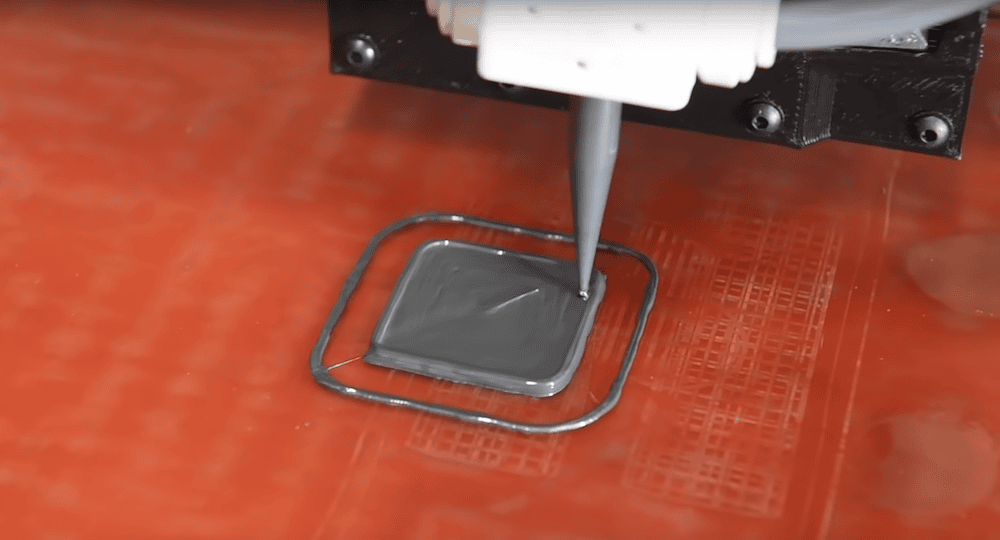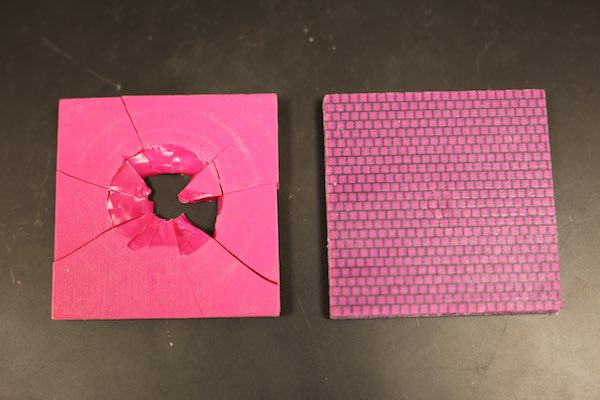
[Image above] Materials science engineers and Army scientists worked together at the United States Army Research Laboratory to build a unique 3D printer that lets ceramics be printed in layered, abalone-shell-inspired geometries. Credit: RDECOM Research Laboratory, YouTube
If we had to pick a song that contrasts the fields of ceramics and polymers, I’m pretty sure a top-runner would be “Anything you can do, I can do better.”
When scrolling through stories concerning new materials science advances, I commonly see the two materials pitted against each other: “Ceramic may replace metal and polymer bone screws,” “Replacing multi-layer ceramic capacitors with polymer capacitors.” The competition between the two materials occurs because while ceramics and polymers differ in many aspects—polymers are flexible and (usually) organic, ceramics are brittle and inorganic—they share some similarities that allow them to be used for the same purpose, for example, as electrical insulators.
One application that sees this ceramic-polymer competition is body armor. Ceramic plates are the traditional material used for creating bulletproof vests due to their significant strength and ability to halt high-speed bullets. However, ceramics are brittle, and repeated hits cause ceramic plates to shatter. In comparison, polymer plates are more resilient (less likely to shatter), but currently they are not tough enough to withstand impacts on the same level as ceramics.

MIT researchers showed that polymer plates with conch-like, criss-crossed features (right) were substantially better at preventing crack propagation. Credit: Melanie Gonick; MIT
In 2017, we published a Ceramic Tech Today post discussing how MIT researchers increased toughness of polymer plates by 3D-printing layers of polymer materials with opposing geometries. Testing proved the conch-shell-inspired structure was 70 percent better at preventing crack propagation than a traditional fiber composite arrangement, and the layered structure made plates less brittle than traditional glass or ceramic materials.
At the time, we noted 3D-printing technologies were more developed for polymers, so a similar layering technique could not be used for ceramics until advancements in ceramic additive manufacturing occurred.
Based on new research, it looks like those advancements have arrived.
At the United States Army Research Laboratory, materials science engineers and Army scientists worked together to build a unique 3D printer that lets ceramics be printed in layered, abalone-shell-inspired geometries, just like the polymers discussed above. Joshua Pelz, ACerS member and materials science and engineering doctoral candidate at the University of California, San Diego, was responsible for designing the custom auger and print head used in the 3D printer.

Abalone shell structure served as an inspiration for design of the 3D-printed ceramics. Credit: RDECOM Research Laboratory, YouTube
“I started working on this project to create next-generation antennas with graded structures,” says Pelz in a press release. “[I] then transitioned into using armor ceramic materials such as boron carbide and silicon carbide and trying to produce parts that had a gradient or internal structures impossible to produce with traditional ceramic forming techniques.”
In today’s video, you can learn how Pelz designed and programmed the new printer—and find out what other ceramic applications besides body armor will benefit from 3D printing (hint: need a new knee or hip replacement?)
It looks like ceramics claim this round over polymers in the battle for preferred body armor material for soldiers. But don’t worry, polymers—iPhone lovers appreciate your abilities!

Credit: RDECOM Research Laboratory, YouTube
Author
Lisa McDonald
CTT Categories
- Material Innovations


